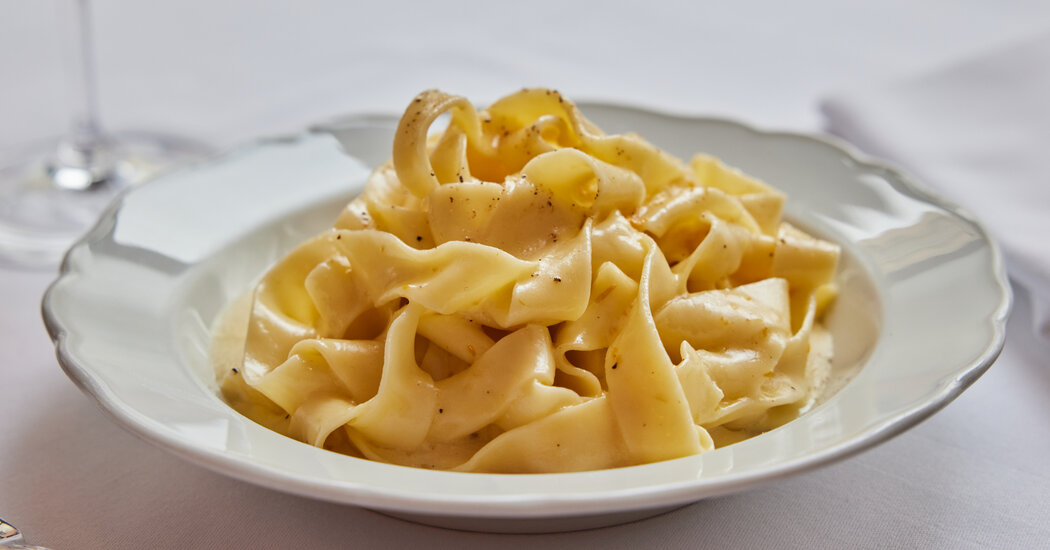
Restaurant Review: I Sodi Returns, Without the Sardine-Can Space
From 2008 until she moved to larger quarters this year, Rita Sodi served plainspoken Tuscan cooking in her plainspoken restaurant on Christopher Street, I Sodi. The dining room was as tightly packed as the coach section of a sold-out flight on Thanksgiving weekend, and it could be difficult to get in or out of your seat without accidentally becoming intimate with a stranger at the next table.
Tuscan cuisine is simple, sometimes to the point of austerity. If you order I Sodi’s excellent grilled branzino, you get the two sides of the fish, boned and spread on a plate like an open book, dressed with a few drops of olive oil. That’s it. Ms. Sodi grew up on a farm near Florence, where minimalism at the stove and the table is the norm. By New York standards, though, her cooking can seem almost stern. One Italian restaurant in Manhattan is known for pumping an oversize raviolo full of cacio e pepe sauce and then stacking it on top of a filet mignon. You can get steak, ravioli and cacio e pepe at I Sodi, too, but not on the same plate.
If you ate at the original I Sodi often enough, you might have formed a mental link between the undecorated food and the tight quarters. They even seemed to be part of a single aesthetic, an unyielding and almost puritanical minimalism.
So when I Sodi relocated in July to a much larger space on the corner of Bleecker and Grove Streets, die-hard fans may have worried. If you could lean back and stretch your legs during dinner, what other forms of decadence might be permitted? Barolo Jell-O shots? Bottomless Negronis?
So far, no. The new I Sodi takes pains to reassure customers that very little has changed except the address. The same fat candles are lined up along the bar. The same white cloths are draped over the tables. The walls are white, the banquettes upholstered in the same Chianti-colored leather, and the wainscoting looks as if it’s been stained with several coats of amaro. Your server will be dressed in the familiar blue Oxford-cloth shirt with a striped tie tucked between two buttons.
You can, as ever, order a Negroni with the usual Campari, or one made with Gran Classico following what’s said to be the original recipe, or one of the cocktail list’s six other variations. If you drink it at the bar, a leather coaster will protect the wood from condensation running down the thin walls of your thick-bottomed glass. I Sodi’s traditions may be just 15 years old, but its bartenders are no more likely to set down a tumbler without a leather coaster than the ones at McSorley’s are to pour you a single mug of ale.
The difference, though, is that there are two fewer seats at the bar and more space between them. The aisle through the front dining room is finally wide enough for a wheelchair to get through easily, and there’s a short ramp down to a second dining room in the back. Beyond that are four tables in a shady, flagstone-paved garden. Wherever you sit, you will not be in your neighbor’s lap.
Ah, here comes an old friend — the fried artichoke antipasto. Stark and sauceless, the leaves deeply bronzed, crunchy as phyllo, these are the artichokes that first turned Jody Williams’s head, before she became Ms. Sodi’s spouse and business partner in Via Carota and the Commerce Inn.)
There are raw artichokes, too, shaved paper-thin moments before they are served so they don’t need any lemon juice, just salt, pepper and olive oil applied by a hand that knows when to stop. They arrive under a tissue-thin sheet of Parmigiano. Another antipasto is made almost the same way with zucchini when the finger-size ones are still in the markets.
Recently the servers were reciting long lists of special tomato salads: big heirlooms the colors of the Italian flag dressed with goat cheese and black olives; bite-size oblongs shiny with oil beside a creamy blob of burrata; juicy Romas grilled and alternated with mozzarella and basil leaves in a variation on the caprese salad. So many tomatoes! Lots of other specials, too.
On some nights the menu seems almost as vegetable-crazy as Via Carota’s. I couldn’t swear to it, but I think some of the pastas are a little more lush than they used to be, a style I also associate with Via Carota. The dozen or so layers of the artichoke lasagna seemed to be held together with more melted cheese than I remembered, the pappardelle al limone swaddled in more butter before a last-minute grating of Meyer lemon. The pesto tossed with long, hand-rolled strands of pici seemed creamier and possibly cheesier, too, although what came through most powerfully was the aroma of basil — like burying your face in a bunch just pulled from the garden.
These changes, if they are real, are shifts in emphasis. Only one pasta I ate seemed to have turned into something else. The spaghetti cacio e pepe was definitely soupier than I remembered, and the animal flavor of pecorino wasn’t as strong. The broken peppercorns, though, hadn’t lost their uppercut.
The breaded pork chop fried on the bone might be more enjoyable if it were not cut so thick. I have no notes on the other main courses, all I Sodi classics: juicy, pale-pink rabbit roasted inside a veil of pancetta; a butterflied Cornish hen grilled under a brick until the skin is crackling and vaguely charred; the hunk of wine-braised short ribs over polenta.
The desserts seem to be untouchable, like the barely sweetened panna cotta with a thick, inky spoonful of blackberry preserves; or the semifreddo of fragrant, toasted hazelnuts; or the crumbly tart spread with orange marmalade.
These are paradigmatic, principled, uncluttered desserts. Maybe the extra oxygen and square footage on Bleecker Street have been good for I Sodi after all.
Follow New York Times Cooking on Instagram, Facebook, YouTube, TikTok and Pinterest. Get regular updates from New York Times Cooking, with recipe suggestions, cooking tips and shopping advice.



